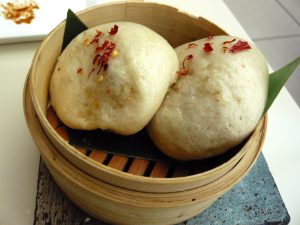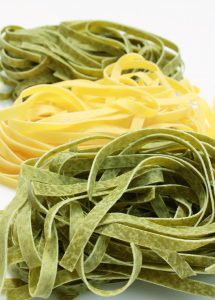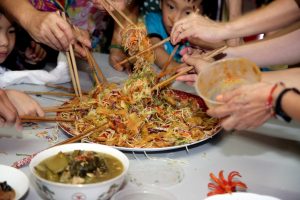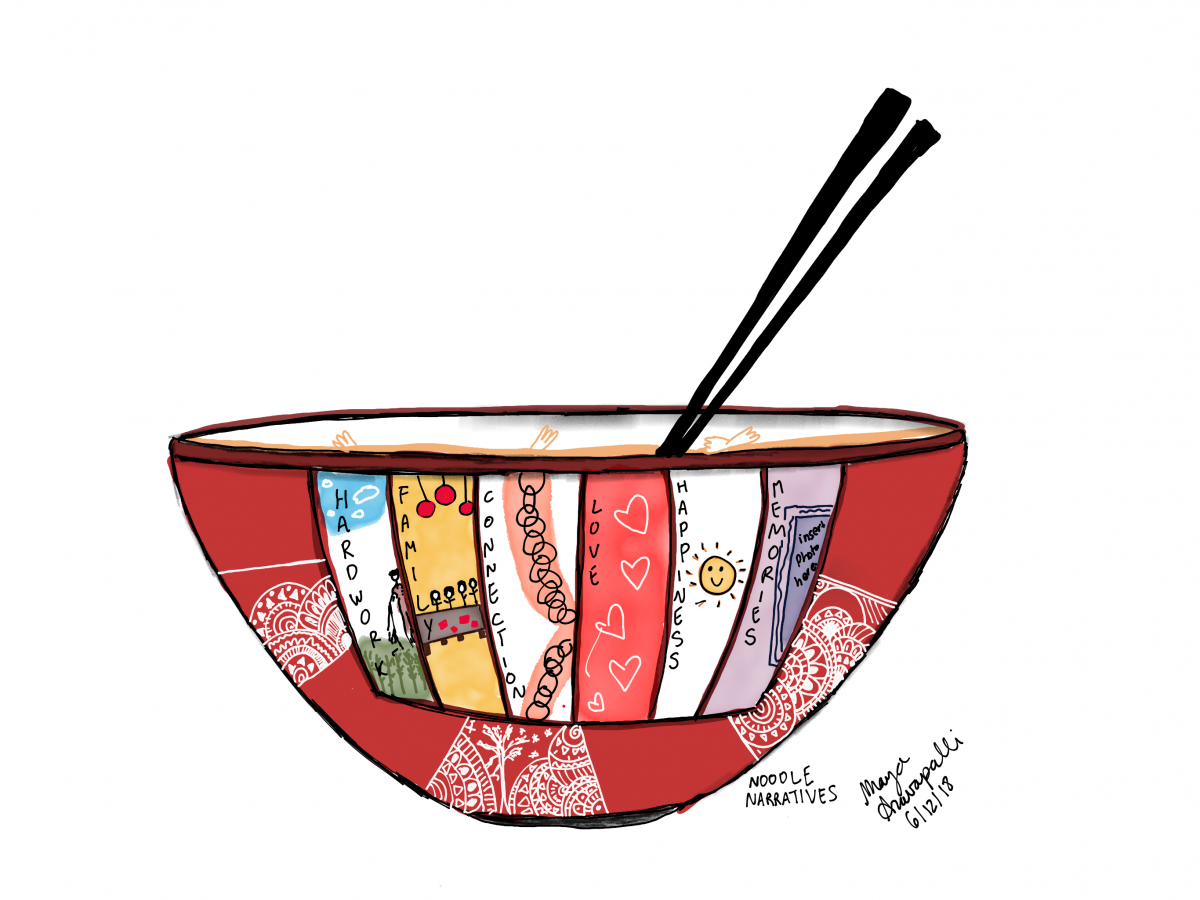The True Meaning of Noodles
By Maya Aravapalli

According to Merriam-Webster Dictionary, a noodle is defined as “a food paste made usually with egg and shaped typically in ribbon form;” however, the noodle comes to represent much more than food for many cultures – especially Chinese and Italian cultures. Last semester, my best-friend and I went to Ponce City Market where we tried ramen noodles for the first time. Once the food was at our table, we indulged in both food and conversation without paying attention to stress from school. It was just us and the two bowls of hot, tasty noodle soup. I didn’t think much about this dinner until now, but it has made me realize how sharing a meal with someone is an experience that the meal comes to represent. The noodle is much more complex and layered than it’s dictionary definition expresses . It comes to represent family, memories, and experiences that will live in one’s hearts and minds forever. In a way, it comes to mean love itself because it brings people together and creates allows for experiences that provide a deep connection with others.
The noodle is ever-evolving and is a food that is available worldwide. It plays a great role in many cultures that have individualized noodle dishes to fit their taste. An example of this is Indo-Chinese cuisine that is so popular in India that it’s even available as street food. The noodle has changed a lot, especially due to changing ideas of health, such as the gluten free moment; however, the importance it has in the world never changes. There is such variety in noodles and its cooking methods that the clinical definition of the noodle doesn’t encompass everything a noodle means. Differences in cooking methods, shapes, and presentation contribute to the wide variety of noodles available. Even Chinese steamed buns fall under the noodle category . Noodles play an integral role in Chinese and Italian cultures and has come to mean much more than food consumed for these people.

Although noodles are eaten all around the world now, they hold a special place in Chinese culture. Noodles emerged in China thousands years ago during the reign of the Han Dynasty. The different types of noodles not only vary in shapes, sizes and cooking methods, but also by region. In China, noodles are part of old traditions and customs. Many noodle dishes, such as the “Longevity noodles”, “Dragon Whiskers Noodles”, and “Sister in Law Noodles”, have stories behind them that rooted deep within the culture. Certain types of noodles are consumed on special days of the lunar calendar, and others are consumed for prosperity and good fortune. Therefore, the identity of noodles is formed by the rich cultural and personal connection it provides to the Chinese culture and people.

Noodles have been present in Italy for thousands of years. Although the origin of noodles in Italy is debated on, there is no dispute about the importance of noodles in the Italian culture. While some argue that Marco Polo brought noodles from China to Italy, evidence shows that noodles’ presence in Italy dates back to the Roman Age. Like noodles in China, Italian noodles, called pasta, come in different shapes and sizes that are influenced by regional differences. Pasta is a staple food in Italy and it provides great nutritious value to meals. Whether pasta is tossed into a salad, cooked into a soup, or mixed into one of the many kinds of sauces, it provides substance and variety into the meal. Many of pasta dishes are made in large portions that allow for sharing. This tradition of shared dining provides an atmosphere that encourages people to form deeper connections with others at the dining table. Pasta is a food that is common all around the world, but it is a salient part of Italian culture. While different regions are known for different styles of noodle dishes , the love of pasta unites the culture of Italy.
In addition to noodles playing a vital role in Chinese and Italian cultures, they also come to symbolize hard work, family, experiences, and comfort. The show, “A Bite of China,” shows the hard work that fresh noodle production requires from the cook. The episode shows people of different parts of China, what they eat, and how the food is produced. The first item that is introduced is Chinese steamed buns. It is an arduous process to create these buns, and the vendor has to make them fresh for the next day’s sale. It made me realize that for these cooks and vendors, preparing noodles is a strenuous process that requires dedication and concentration. No wonder the value of not wasting food is present in many of the world’s cultures. In this sense, noodles represent something much greater than the finished product. It represents the great care needed to make the noodles.

The documentary also showed a clip of a family gathering that only happens a few times a year. In the gathering, the family bonds over the plethora of food, and the environment is very intimate. Young children dig into their food, and it becomes clear that the children will forever remember the delicious meals and strong family connection present in the room. Therefore noodles, or any food shared in a family environment, comes to represent cherished memories and connection with other family members. Shared dining is big part of many cultures, especially Chinese and Italian cultures. While the family gathering only lasts for a short period of time, the memory and experience is engraved into one’s mind for far longer. Finally, noodles also represent comfort because it is a standard food and is available almost everywhere in the world. Italians consume about sixty pounds of pasta per year. It is easy to find many varieties of noodles in many parts of the world due to improvements in production and technology that led to instant and dry noodles. There is nothing better than a warm bowl of noodle soup when you are sick. Hence, noodles could also come to represent comfort in a time of distress.
Noodles reflect different cultures, regions, and cities by providing a form of identity. For example, the Italian city of Bologna is known for its fresh pasta – especially tagliatelle. Naples is known for Spaghetti. The Chinese “Long Life Noodles” is a prime example of how noodles represent the Chinese culture. It is a specialty dish served on birthdays, and it is a celebration that will be remembered forever by family members. Without the noodles, the birthday wouldn’t be as special because it is a Chinese tradition that has been around for many years. The idea of “longer the noodle, longer the life” has deep symbolic meaning within the Chinese culture. These are only a few examples of how noodles have shaped the identity of Italian and Chinese cultures.
Dictionary definitions of the noodle are succinct and technical; however, the noodle is far more complex and symbolic. It has a deep history, takes on a vast number of forms, comes in many shapes and sizes, and represents the rich identity of many cultures, regions, cities. While one could write pages while attempting to provide an all encompassing definition of the noodle, I designed an image that I hope exposes the depth of the definition of the noodle.

My drawing represents the symbolic meaning of noodles and what it contributes to our lives. Through depicting a bowl of pasta with chopsticks, I include both the countries that this paper is centered on – China and Italy. The bowl has panels that show the symbolic meaning of a bowl of noodles. Finally, I chose the color of the bowl to be red because it represents warmth. The drawing was inspired by “Crossing the Bridge,” where a boy is locked in a room to prepare for the Imperial Exam and he does not eat anything the cook brings him. Finally, the chef brings a soup that the boy had when he was three years old, and he eats the soup and passes the exam. This bowl of food represents the different forms noodles can take, what noodles symbolize, and the history behind noodles in the Chinese and Italian cultures. Although the form of the noodle is ever-evolving, and has evolved from fresh pasta to dried pasta to and instant noodles, they will always represent deeper meaning of many cultures. All of these aspects combined forms the true meaning of noodles.
P.S:
If you would like to visit the Ramen Noodle restaurant in Ponce, here is a link to their website 🙂
Sources
“Noodle.” Merriam-Webster, Merriam-Webster, www.merriam- webster.com/dictionary/noodle.

Dear Maya, I really liked your definition of the noodle; it’s such a lovely way of understanding this culturally significant food! Your reference to the “Bite of China” show is really helpful to your discussions. One suggestion I might have for you is try to establish more connections to the readings we’ve talked about in class, and maybe use them to strengthen some of your views.